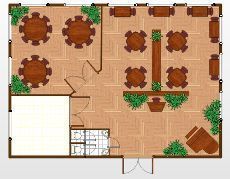
If you had to choose between a restaurant with a nice, quiet ambience with privacy versus a restaurant where people are bumping into each other amid noisy atmosphere where would you take your date for dinner? This is the difference floor plan can make. A good floor plan can create a sense of privacy and quietness in the restaurant. It can also increase the productivity and sales at any restaurant. That’s why you have to pay careful attention to how various sections of the restaurant are laid out.
There are three factors you need to consider when working on a restaurant floor plan. The overall layout, including different sections, help create areas of special interest. The dining area layout determines how many customers you can accommodate as well as how the dining experience for your customers. Finally, the kitchen layout is often not paid much attention to, but it can have significant impact on your staff productivity. The sections below show what you need to consider in each of these areas.
Overall Floor Plan
Designing your restaurant with specific sections in mind and varying floor plans creates a welcoming atmosphere. It also helps you separate the bar from the main dining area as well as possibly child-friendly tables from quiet couple’s tables. Anyone who has sat next to a crying child while having romantic dinner with a date can appreciate the importance of separate sections. Having dips and raised areas also help to highlight an area of interest. For example, if you have a pretty water feature or a view into the kitchen, elevated floor levels can highlight these areas.
Dining Area
The layout of the main dining area is undoubtedly the defining feature of your restaurant, so it is important to design it carefully. Understand the type of clientele you plan to attract and design the dining area that caters to them. Do you need a pre-dinner cocktail area? How about a separate room to cater to large parties? How will you accommodate groups of 2, 4 or 10 people? All of these questions need to be thought out before settling on a floor plan for dining area. Placing two person tables is relatively easy as these can make use of window and corner spaces, while having corner booths will create intimate atmosphere, but will limit flexibility. A modern contemporary eatery may favour perpendicular and parallel seating while pubs and bistros can suit clusters and small circles of tables for a traditional, homey feel.
Kitchen
In addition to providing customers with a great experience, you must also ensure your restaurant design is comfortable and efficient for your staff to use. You need to pay careful attention to how the kitchen is laid out. Poky kitchen spaces slow productivity and can be a major health and safety risk if equipment and dangerous appliances leave room for little else. Cafes and restaurants generate heavy traffic on weekends and you need to ensure you servers and waiting staff can handle the traffic comfortably, while also giving your kitchen staff adequate space to prepare and store supplies.
When sketching out your kitchen and bar area, you will undoubtedly be looking to save space and money on much needed appliances. The catering suppliers such as Fridgeland house a range of equipments in varying sizes to fit in with any cafe or restaurant floor plan. They can provide the right equipments to fit your floor plan.






